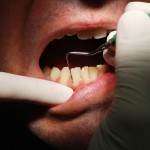
Periodontal disease is very common with diagnosis, disease monitoring and progression being based on assessment of clinical attachment level and radiographic bone loss. While these two measurements are in regular use it is unclear if they accurately assess the extent of the bone level with studies suggesting a variable degree of correlation.
The aim of this review was to determine the accuracy of clinical and radiographic measurements of infrabony periodontal defects.
Methods
A protocol was registered on PROSPERO and searches conducted in the Cochrane CENTRAL and Medline/PubMed databases with no restrictions. Clinical trials in patients aged 18 or older with at least one infrabony defect and measurements of clinical attachment level (CAL), radiographic bone level (rBL), with intraoperative bone level (iBL) used as the reference standard were considered. Two reviewers independently selected studies and extracted data using the Quality Assessment of Studies of Diagnostic Accuracy-2 (QUADAS-2) to assess study quality. The Grading of Recommendations Assessment, Development and Evaluation (GRADE) system was used to rank the evidence
Results
- 10 studies reporting 17 comparisons were included.
- 6 studies were randomised controlled trials, 3 prospective clinical trials, 1 retrospective and 1 cross-sectional clinical trial.
- Sample sizes ranged from 19-129 patients.
- When comparing CAL and iBL, all 17 comparisons showed the clinical measurement values were lower than the iBL values.
- Comparing rBL and iBL, all 17 comparisons showed that radiographic measurement values were lower than the iBL values.
- Comparing CAL and rBL:-
- 7 comparisons found that clinical values were lower than radiographic values.
- 10 comparisons showed clinical values were higher than radiographic values.
- The values of the CAL and rBL measurements underestimated the iBL values with meta-analyses showing a significant difference (see table).
| Comparison | No. of studies (comparisons) | Difference of means (95%CI) |
| CAL with iBL | 10(17) | −1.22mm (−1.49 to −0.95) |
| rBL with iBL | 10(17) | −1.10mm (−1.34 to −0.85) |
| CAL with rBL | 10(17) | −0.05mm (−0.39 to 0.28) * |
* Not significant
Conclusions
The authors concluded: –
The results of this systematic review and meta-analysis show that both clinical and radiographic measurements substantially underestimate the bone level when compared to intraoperative level measurements. However, there was no significant difference in the results between the clinical attachment level measurements and the radiographic observation.
Comments
The reviewers have searched two major databases identifying 10 studies with a range of study designs that met their inclusion criteria. As the authors indicate the included studies did not set out to purposefully investigate the accuracy of the various measurement consequently none of the included studies fulfilled at the QUADAS-2 criteria. One of the main risks of bias was related to the reporting of the reference standard and interpretation of the reference standard results without knowledge of the index test. In addition, for two studies CAL values were constructed from probing pocket depth (PPD) and gingival recession (REC) values. Radiographic techniques also varied between studies. While the review shows that clinical and radiographic measurements of the bone level underestimate the true bone loss by an average of 1 mm the available evidence has only low to moderate certainty.
Links
Primary Paper
Clark-Perry D, Van der Weijden GA, Berkhout WER, Wang T, Levin L, Slot DE. Accuracy of clinical and radiographic measurements of periodontal infrabony defects of diagnostic test accuracy (dta) studies: a systematic review and meta-analysis. J Evid Based Dent Pract. 2022 Mar;22(1):101665. doi: 10.1016/j.jebdp.2021.101665. Epub 2021 Nov 12. PMID: 35219456.
Review protocol on PROSPERO database
